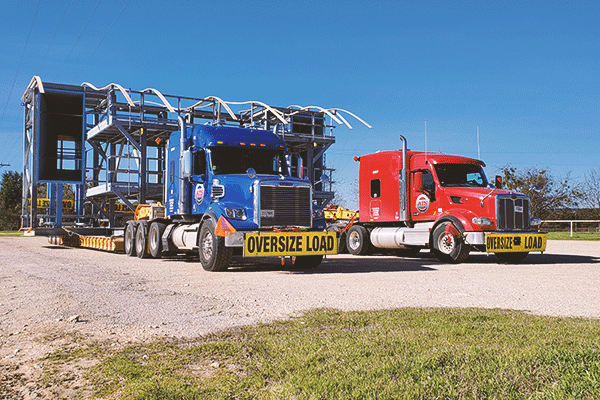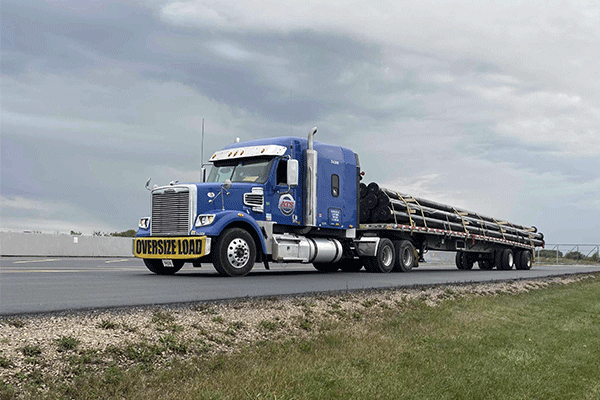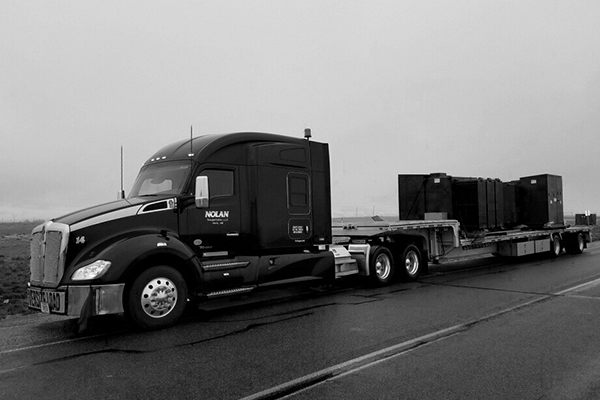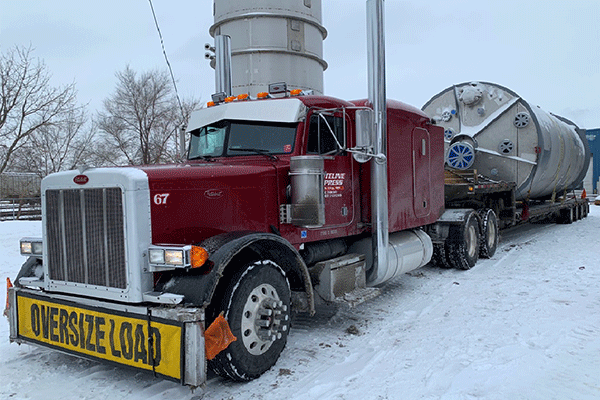You’re looking to nail down some permitting for an upcoming shipment. But you don’t know how to go about doing so, how much time it will take to obtain the permit, how long the load may take to move . . .
About the only thing you know for sure? You have a lot of questions about what information you’ll need to facilitate the oversized load permit process.
Since you’re hoping to make this process as smooth as possible, you already know this information is vital to the success of your shipment. Now, all that’s left is to get the facts and take the right steps.
Here at Anderson Trucking Service (ATS), we’ve been helping shippers get the oversized load permits they need for decades. As such, we understand the intricacies of this process and what it takes to get it right. It’s time you did too.
Below, we’ll outline:
- What is a permit load?
- When does a load require a permit?
- How to get oversized load permits
- What do oversized load permits cost?
- How long does it take to get oversized load permitting?
P.S. — Stick around to the end to get our expert tips on how to make the permitting process as seamless and simple as possible!
What is a Permit Load?
A permit load is any load that is too big or too heavy to legally transport.
We call these oversized or over-dimensional (OD) loads, as one or more dimensions measure over the legal limit.
The legal limits in question can be federal, state, county or township-level restrictions and regulations. Each state has its own rules regarding legal freight dimensions and weight, which is part of what makes OD load permitting so involved.
Related: Freight Measurements Matter: Dimensions and Piece Count in Freight Shipping
When Does a Load Require a Permit?
Oversized load permits are required for non-divisible shipments that exceed the legal dimensional limits for the states, counties and townships they traverse during transit.
These limits are not standardized across the board. Dimensional thresholds fluctuate greatly from one state, county and town to the next.
Even the way permit prices are calculated — be it by the dimension of the load, tons of weight, weight increments, per mile or a combination of these factors — changes substantially from one state to another.
This makes hauling oversized loads especially complex. The ease with which you obtain your over-dimensional load permits depends largely on the accuracy of the information you provide and the timeliness with which you provide it.
How to Get Oversized Load Permits
Before you start hauling oversized loads, it’s critical to thoroughly understand the permitting process and what it means for your shipping costs and timeline.
There are three main steps to getting oversized load permits:
- Understand your freight’s route
- Determine what permits you’ll need
- Actually obtain the necessary permits
Let’s start with planning and understanding your shipment’s route — including the costs associated with taking sub-optimal routes.
Step 1: Understand Your Freight’s Route
Before the process of obtaining the permits needed to move your freight begins, you’ll want to figure out the best route possible for your shipment.
As jurisdictions change from one state to the next, so too do permit requirements and the cost of purchasing them. Moving over-dimensional (OD) freight can get expensive, so the more you can do to keep your shipment’s route as wallet-friendly as possible, the better.
Unfortunately, planning your shipments route — without the help of an expert — can be nearly impossible. The varying regulations, permitting processes and associated costs are just that complex.
Let’s look at an example. You have a shipment that’s 12 feet, 7 inches wide and needs to travel from Wichita, Kansas to Des Moines, Iowa. If this were a normal load with legal dimensions, the best-fit route would take this shipment straight through the upper half of Missouri.
But because this load exceeds 12 feet, 6 inches in width, moving it within Missouri will require escort vehicle services. Escort car services, also called pilot car services, are typically billed on a rate-per-mile basis ranging between $2-$3 per mile plus a per diem if needed over multiple days.
This means that the most cost-conscious route for this particular shipment isn’t the most direct one.
Instead, moving this shipment up through Nebraska — a state with flat permitting fees and where an LED light bar can be swapped for an escort vehicle on divided highways — and then on to Des Moines may cut down costs substantially.
Changing up your route in this manner will add overall miles, but in the end, you’ll actually save money.
These are the kinds of problems that transportation providers solve every day, which is why we strongly recommend leaning on your provider’s expertise in route planning.
If you — or your transportation provider — didn’t understand the rules and regulations for oversized transportation that are unique to each state and county throughout Nebraska, Missouri, Iowa and Kansas, those savings wouldn’t be possible.
So, seriously: Work with your transportation provider to figure out your freight’s best route before beginning the process of securing permits.
Doing so will help you avoid costly delays, as all necessary permits have been purchased before the process of moving your shipment begins.

Step 2: Figure Out What Kind of Permits You’ll Need
Most oversized loads will need at least one of the following types of permits, depending on their route:
The type of permitting you’ll need to get primarily depends on which entity owns the road your load will utilize.
For freight moving along an interstate highway, for example, a state permit is needed. For freight that needs to move throughout a metropolitan area, local routes will require local permitting.
When Do You Need State-Level Over-Dimensional Permits?
Any time you’re moving freight that exceeds the legal dimensional limits for your equipment type — whether it’s over in total weight, length, width or height — you’ll need to get an OD permit for every state it travels through.
Although the prices of these permits fluctuate substantially from one state to another, when oversized freight is transported along any state-owned road such as a highway or interstate, you’ll need permitting.

When Do You Need County Level Over-Dimensional Permits?
When your OD load is transported along a county-owned road such as a county highway, you’ll need to get a permit to do so from the local governing body.
Once again, these rates will change depending on the county you’re moving freight in and the weight/dimensions of the load in question.
When Do You Need Township or City Permits?
Often, oversized freight needs to be moved within the confines of a city or town at either end of its journey. To move loads in these areas, you’ll likely need an additional permit issued directly by each town’s governing body.
The best transportation providers boast home-grown automated systems to help them estimate the cost of each load’s permitting requirements. Since these rates fluctuate so frequently, systems like this help these companies offer the most up-to-date information to assist their customers.

Step 3: Obtain All Necessary Permits
Once you’ve determined your route and the type of permitting you’ll need, your next step is simple: Go and get them! For the companies that need them, permitting for OD loads can be obtained in one of two ways.
How To Obtain Permitting Directly From Each Governing Body
To get an oversized permit in a state, county or town, shippers and/or their transportation provider are often required to have a pre-existing account with each governing entity.
To hold some of these accounts and secure consistent permits for their customers, transportation companies may need to sign contracts and bonds. These documents signify each company’s ability to obtain a permit for their freight and, when consistently maintained, serve to expedite this process.
Although the investment to maintain these contracts can be hefty on the front end, many trucking companies have no trouble shouldering this burden. Providing a high level of service to their customers is made easier by holding permitting accounts in the areas they frequently service.
These accounts allow companies to obtain a permit quickly, and relatively inexpensively, as they’re able to forgo paying the fees associated with using a permitting service.
Find a transportation provider that holds accounts in the areas you’re looking to move a load through.
Doing so can save you money on your freight rates and help you stick to your timeframes.
Assuming your transportation company has an ongoing account with the states you’ll be moving through, securing permits can be done quite easily — if you help the process by providing accurate information.
To get correct pricing on your permits and receive them in a timely fashion, you’ll need to supply information including but not limited to:
- Transportation provider’s DOT number
- Truck and trailer information
- Make, model, serial numbers, license plate, state, equipment dimensions, axles, spacing distance
- In-depth descriptions of all freight
- Height, weight, length, width, exact nature
- Starting and ending points
- Target transportation date
The information you’ll need to relay will change depending on the requirements of the party you’re working with.
But regardless of what information is requested, ensuring all information you provide is detailed, accurate and up-to-date is crucial.
Inaccurate permitting information can lead to delays, fluctuating costs, and headaches on the part of both you and your transportation provider.
The best thing you can do is work closely with your provider throughout the process, as they will know best which carrier-specific details you’ll need to supply.
How To Obtain Permits from a Permit Service
If you’re looking to move freight on your own but don’t hold an account within the necessary areas, you’ll need to utilize a permit service.
Permit services are companies that work to obtain transportation permits for their customers. Among other things, permit service providers utilize their comprehensive understanding of each state’s permitting requirements to secure the oversized permits their customers need.
Working with permitting service providers can save you time and money as they utilize their expertise to fit your freight with appropriate legal permitting.
Related: 6 Oversize/Overweight Permit Companies to Consider Using in 2024 (+ How to Choose)
That said, not all companies will help you plan your shipment’s route.
If you’ve already selected the most cost-effective route for your shipment and only need assistance securing permits, these services will fit your needs nicely.
In this case, you’ll simply need to supply all necessary information to your permit service provider and let them secure your documents.
It’s important to note that the companies offering these solutions tack a service fee onto the price of getting your load’s permits. Be sure to factor this cost into your budget when determining the best solution for you.

What Do Oversized Load Permits Cost?
While the process of getting OD load permitting can be relatively straightforward, determining the price of those permits can be anything but.
As we’ve already discussed, the cost of your oversized load permits will depend on a variety of factors, from your shipment’s dimensions to the exact route it will be taking to reach its destination.
While your costs will be affected by many elements depending on the state you’re moving freight through (like the number of bridges your load will cross — thanks for that logistical minefield, Louisiana!), weight is perhaps the most impactful.
Each state handles overweight load permitting differently; some price per ton, others per ton per mile, and others still implement a flat rate.
For example, permitting OD freight under 200,000 pounds is billed at a flat fee in Nevada and an incremental rate in New Mexico. If you’re moving through both states, you’ll need to be aware of both costs.
Related: What Does Heavy Haul Trucking Cost?
These variances in price structure can make estimating your permitting costs tricky — and that’s before you get into the weeds on the complex and specific mathematical formulas each jurisdiction uses to find that final cost.
But you don’t have to go it alone — in fact, we strongly encourage working with a reputable transportation provider to navigate the nuances of permit pricing. A good provider will help you understand how the many variables at play will influence your shipping costs and plan the best possible route for your shipment.
How Long Does It Take To Receive Permits?
Provided that you or the transportation company you work with have an active account with the states and jurisdictions you need permitting in, this process should be quick and painless.
Permitting a 2-axle trailer — like products moved on a traditional flatbed, step-deck and lowboy — should be relatively quick, if not instant.
For other over-dimensional freight that is on the small side (less than 53 feet long, 14 feet wide, 13 feet, 6 inches high, and weighs less than 45,000 pounds) expect to get your permits processed and approved within four to eight hours.
Conversely, if the total weight and/or dimensions of your freight exceeds these thresholds, permitting may take a bit longer.
The larger the load, the more difficult moving it from A to B can become. Construction limitations, district review, bridge engineering and pre-run surveys all need to be done on your shipment’s selected routes, extending the overall time frame of your permitting process.
As a result, it’s not uncommon for OD permits on larger shipments with these requirements to take between two to six weeks to receive.
Make Your Over-Dimensional Permit Process Easier
Although moving oversized and overweight freight isn’t simple, it doesn’t need to be stressful.
Having the right transportation partner — one with the experience, competencies and expertise you need — can remove a lot of the complexity from this process.
Too often, shippers overpay for their OD freight because they fail to understand the role a skilled partner can play in this process. The companies that move large freight day in and day out know what they’re doing — and they can help you do it, too.
But how can you choose? And how can you verify that the company you trust with your freight, budget and supply chain has the experience you need to get the job done?
Before tendering your freight, ask any potential provider questions like:
- “What is your history of moving loads like mine?”
- “What can I do to save money on my permits?”
- “Do you hold accounts in the states I’ll need permits in?”
- What is your experience working with permitting service companies?”
- “Do you have an internal system for estimating permit and escort costs?”
The way transportation companies respond to these queries will give you a good idea of their capabilities. Routing over-dimensional freight isn’t a “fake it ‘til you make it” enterprise. Great companies will answer these questions fluidly and transparently.
Now that you’re armed with the knowledge you need to select a reliable partner for your oversized freight, it’s time to vet your candidate pool. Check out our free Heavy Haul Carrier Selection Checklist for a step-by-step guide to evaluating potential carriers. We designed it to help shippers like you find the best-fit partner for your freight, so you can be the supplier that always delivers.
You can also request a quote from ATS to get a better idea of the cost of moving your oversized load.
Our experts will help you understand all the factors that go into your final shipping costs, including any necessary permitting, and work to find the best, most cost-effective route for your freight. Reach out today to get started!


